The word ‘Passport’ derives from the french word ‘passe’ and ‘port’. In ancient times with valid papers you are allowed to pass through land or sea city gates (ports). Today passports have come a long way and evolved through space of time from papyrus handwritings to biometric chips holding finger prints.
One of the earliest known references to paperwork that served in a role similar to that of a ‘passport’ is found in the Hebrew Bible. Nehemiah 2:7-9, dating from approximately 450 BC, states that Nehemiah, an official serving King Artaxerxes I of Persia, asked permission to travel to Judea. The king granted leave and gave him a letter “to the governors beyond the river” requesting safe passage for him as he traveled through their lands.
In the medieval Islamic Caliphate (middle east) from 632-1258 AD, a form of passport was the bara’a, a receipt for taxes paid. Only people who paid their zakah (for Muslims) or jizya (for dhimmis) taxes were permitted to travel to different regions of the Caliphate; thus, the bara’a receipt was a “traveler’s basic passport.
King Henry V of England is credited with having invented what some consider the first passport in the modern sense, as a means of helping his subjects prove who they were in foreign lands. The earliest reference to these documents is found in a 1414 Act of Parliament. In 1540, granting travel documents in England became a role of the Privy Council of England, and it was around this time that the term “passport” was used. In 1794, issuing British passports became the job of the Office of the Secretary of State.
Since then references to identity papers such as passports, citizenship certificates, safe passage documents are collectible and such documents used in 16th and 17th century are extremely rare to find.
- Historical passports from extinct non-existent countries such as Yugoslavia,Czechoslovakia, Austro-Hungary empire, East Germany are also rare to find. Passports from famous and well known people and celebrities are extremely collectable.
- Laissez-pass UN issued documents during war are also hard to find
- German passports and identity papers issued to Jews during war are desirable and rare
- Passports of well known people and celebrities have huge value.
- Naval passports and identity papers for sea travel have enormous value attached to them.
- Nansen passport papers and Schutz-Pass (protective passports) are also quite rare to find.
The following are some of the rare and valuable passports we have compiled..
1641 England Passport
The oldest passport still in existence was issued on 18 June 1641 and signed by Charles I. The document is signed by Charles. R — commonly known as King Charles I — licensing Sir Thomas Littleton “to passe out of this our realme into the part beyond the Seas, there to remayne the space of three yeres.”
The passport sold at auction in 2016 for £1,375 ($1,750) in Knightsbridge in London in an auction held by Bonhams.
According to the text, Littleton was travelling with four servants, fifty pounds and “his trunckes and necessaries,” and was forbidden from venturing into the realm of any “foraine Prince or Potentate not being with us in league or amitie.”

Malta Sovereign Military Order Passport
The Sovereign Order of Malta is one of the oldest institutions of Western and Christian civilisation. A lay religious order of the Catholic Church since 1113.
Founded in the 11th century in Jerusalem, the Sovereign Military Hospitaller Order of St John of Jerusalem of Rhodes and of Malta is a lay religious order of the Catholic Church and a sovereign subject of international law.
The Sovereign Military Order of Malta passport is a travel document issued to officials and diplomats of the Sovereign Military Order of Malta(SMOM). Currently there are only 500 passports in use.
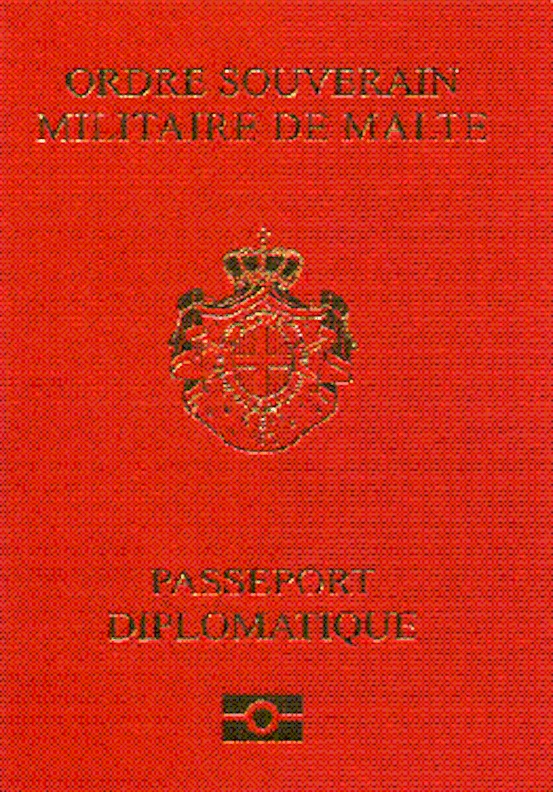
1832 US Passport
Before he invented the telegraph, Samuel Morse traveled to Europe twice to study art. This was the passport he used for his trip in 1829. In it, he identified himself as an “Historical Painter and President of the National Academy of Design.” However, Morse would soon become better known as an inventor. It was on his voyage home from that trip in 1832 on the Sully that he first envisioned the electromagnetic telegraph.
This image is taken from Library of Congress
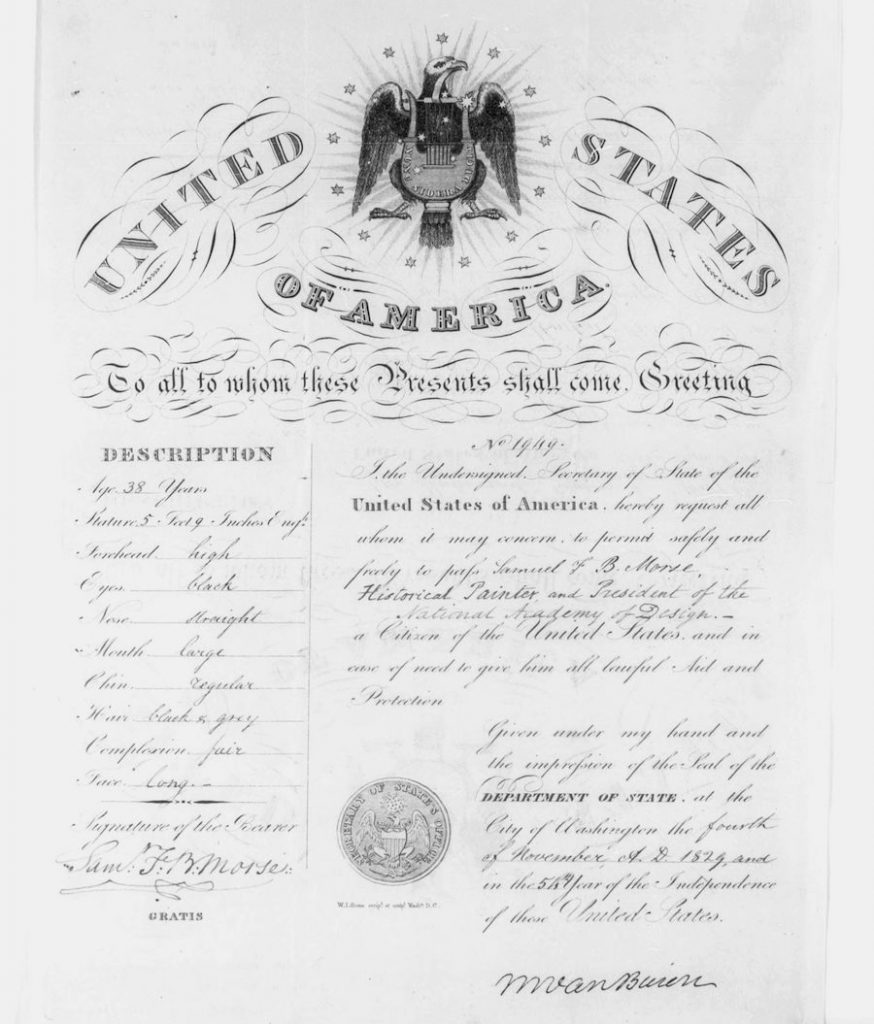
Albert Einstein 1923 Swiss Passport
This is the original Albert Einstein passport issued in 1923.
It is currently held at Historical Museum in Bern

1769 German Passport
Passport issued for English traveller in Germany, 1769 for travel by horse carriage. The image of horse and carriage to left.
It is held in British museum
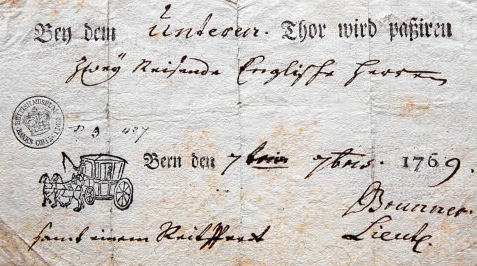
Roman Diplomas
The most common document identifying a person in Ancient Rome was ‘diploma’, first issued in 52 AD
Roman citizenship of discharged soldiers was identified by ‘military diploma’
This one is a military diploma from AD 80 etched and inscribed in Bronze.
1963 Churchill US passport
ON APRIL 9th, 1963, a deeply moved Sir Winston Churchill, sitting in his London home with his wife beside him, watched a satellite relay of a White House ceremony giving him honorary US citizenship.

Nansen Passports
Nansen passports were first issued by the League of Nations from 1922 to 1938 to stateless refugees. This little known passport saved 450,000 lives The Nansen international office for Refugees was awarded 1938 Nobel peace price.
Not many people would know, this passport saved 450,000 lives. This one is issued by France with refugee visas to Armenia.

Joint India Pakistan Passport
The Joint India Pakistan Passport is very rare. This one was issued in 1963 from Amritsar for Sikhs on pilgrimage to Pakistan.

British Indian Passport
The British Indian passport was a passport, proof of national status and travel document issued to the British subjects of the British Indian Empire, British subjects from other parts of the British Empire, and the subjects of the British protected states in the Indian subcontinent (i. e. the British Protected Persons of the ‘princely states’). The title of state used in the passport was the “Indian Empire” which covered Aden, Ceylon, Pakistan, Bangladesh, Burma, and non French and Portuguese India.
The use of the passport was discontinued in Aden and Burma in 1937, on becoming independent colonies, and in 1948 in the new Dominions of Ceylon, India and Pakistan.
In India, The use of passports was introduced to the British Raj after the First World War. The Indian Passport Act of 1920 required the use of passports, established controls on the foreign travel of Indians, foreigners travelling to and within the Presidencies and Provinces of British India.

1866 Japan Passport
The first travel documents for overseas travel by Japanese citizens were introduced in 1866, near the end of the Tokugawa shogunate. These documents took the form of a stamped “letter of request” allowing Japanese citizens to travel overseas for business and educational purposes. The term “passport” was formally introduced into the Japanese language in 1878, and in 1900 the first regulations governing the usage of Japanese passports were introduced.
The is the First Japanese passport, issued in 1866.

1964 British Colony of Antigua Passport
Antigua was first settled by archaic age hunter-gatherer Amerindians called the Ciboney and the earliest settlements started around 3100 BC. The English settled on Antigua in 1632 to 1981 with a brief french iterlude in 1666.
Antigua and Barbuda became an independent state within the Commonwealth of Nations on 1 November 1981. Today the population of the islands stands at 103K.
This is a rare Antigua passport issued in 1964 when it was a British colony.

Schutz passports
Schutz-pass or protective passports were issued to hungarian jews in the holocast saved thousands of lives. By the end of October 1944, more than 1,600 Jewish people in Budapest were able to obtain documents.
Raoul wallenberg posted in swedish embassy issued it to people in 1944 to jewish families. Wallenberg distributed thousands of these ‘Schutz-Passes’ or ‘Wallenberg passports’ —official-looking, but essentially invalid, Swedish passports granting the Hungarian bearer immunity from deportation.
Schutz pass isn’t a real passport, you couldn’t travel with it but it meant that you were protected by the Swedish embassy.
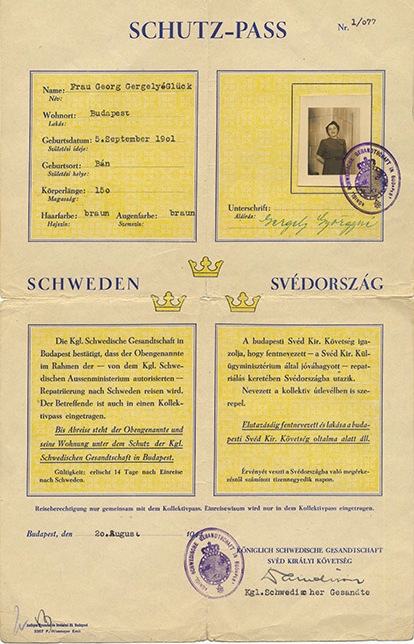
German J Passports
On October 5, 1938, just before the start of WWII ,Germany’s Reich Ministry of the Interior invalidates all passports held by Jews, became valid only after letter “J” has been stamped. By autumn 1938, all Jewish passports were stamped with red letter “J” for Jew.
Jewish German passports with J are very rare and collectible.

Naval Sea Passports
Naval sea passports were issued to entire ships and crew members carrying merchandise and other items to pass through enemy seas unhindered. In the mediterranean, it was called ‘mediterranean passports’. These passports are extremely rare and most valuable collector items.
Mediterranean Passports were issued to American ships that traveled in the Mediterranean Sea and provided protection from attack by ships of the nations collectively known as the Barbary Coast powers. Treaties made by the United States between 1786 and 1836 with the Barbary Coast nations of Tunis, Tripoli (today Libya), Algeria, and Morocco included a provision that American ships carrying this passport would be allowed to pass unmolested.
This document is a British Mediterranean Passport issued to the Brig Athille from London in 1814
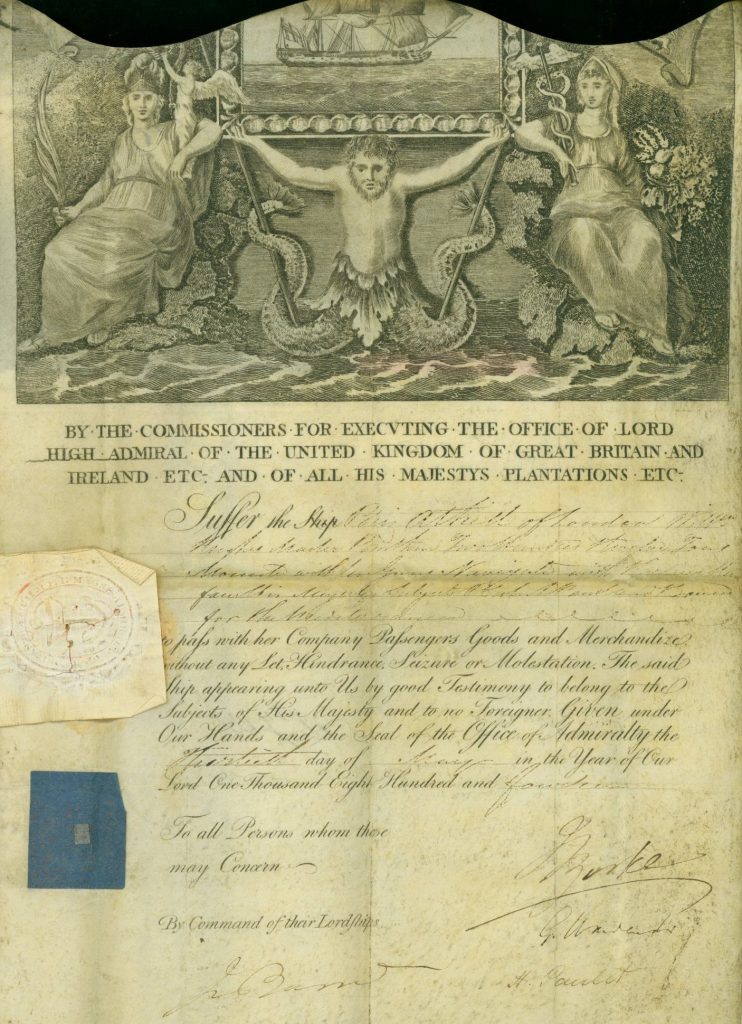
Passport Masks
In Africa and Australia, there were records of aboriginal tribes using ‘masks’ to identify themselves.
Well before paper passports, African aboriginal tribes used colorful masks to identify their tribes when when traveling across the continent. These were called ‘passport masks’.
Passports were not always paper based like we believe today.
http://www.arts-are-essential.org/saproject06/lesson_plans/pp_passportmasks.pdf

1881 British Passport
A Rare British passport dated 1881 issued to British subject to travel on the Continent. This passport was issued by Foreign Office in London.
If you look closely, there is a partly visible stamp on the bottom left (above signature of the bearer), shows the document was issued for SIX PENCE
It is held in Victoria Museum Australia

1780 French Passport
French passport issued in 1780 signed by Foreign minister Vergennes during King Louis XVI last king of france who was guillotined in 1793. This passport was issued to Dr Broussonet, a professor and physician at Montpellier university, for travel to England.
It is held in British Museum

Canada 1863 Passport
The First Canadian passports were issued in 1862 following the outbreak of the American Civil War when US demanded identity. These were called ‘Letter of Request’ from Governor General of Canada until 1915
Below is the 1863 Canadian Passport
Anderson Ruffin Abbott was born in Toronto to a prominent black family who left Alabama as “free people of color” and relocated to Canada in 1835 or 1836. He served as physician.

Credit: http://www.buxtonmuseum.com/history/PEOPLE/abbott-anderson.html
1866 Japan Passport
First travel documents in Japan were introduced in 1866. It was called stamped letter of request.
Passport was formally introduced into the Japanese language in 1878 and in 1900 first regulations for use of Japanese passports were introduced
This one is 1866 Japanese passport

About World Passport Museum

The World Passport Museum is set to open its first museum in London/Zurich by 2021. It is a non-profit initiative to display historical passports and other identification documents from history.
We perceive old historical identity papers such as passports, visas, other identity papers as a true human art. These days all documents such as passports and other documents are printed and have totally lost human handwritings completely (obsolete).
Almost all valuable identity papers and old documents have been destroyed, thrown away for being worthless. We want to save history and preserve them from becoming extinct. Further, as the world is fast pacing towards digital world and soon paper passports will be extinct and phased out. There arise a greater need to preserve paper documents with human writings.
The museum will aim to collect any document that has historic value from 1600’s to 1950 era from over 200 countries in the world working closely with non-profit organizations, museums and governments. The World passport museum will exhibit travel documents such as: Passports, Visas, Citizenship certificates, Tax bills, other identity document from history.
The World Passport museum seeks small donations or contributions. If you have any old passports, or any identity papers from 1900’s or before, please donate to us for the museum initiative.
Please visit passportmuseum.org






